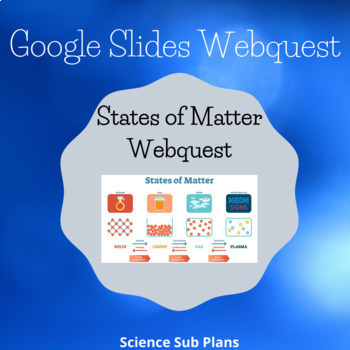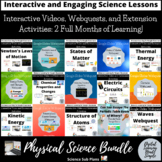States of Matter Interactive Webquest
- Google Drive™ folder
- Webquests

What educators are saying
Also included in
- 3 DAYS OF COMPLETE SCIENCE LESSONS! NO TEACHER PREP!NO TEACHER PREP! ANSWER KEY INCLUDED. SHARE THE LINK WITH STUDENTS OR POST ON GOOGLE CLASSROOM AND LET THE LEARNING BEGIN! THIS RESOURCE INCLUDES:A PDF version of all documentsA Google Doc version- Ideal for posting directly to Google ClassroomDaysPrice $6.38Original Price $7.98Save $1.60
- 3 DAYS OF COMPLETE SCIENCE LESSONS! NO TEACHER PREP! ANSWER KEYS INCLUDED. EXTENSION ACTIVITIES TO INCREASE STUDENT UNDERSTANDING AND COMPREHENSION! SHARE THE LINKS WITH STUDENTS OR POST ON GOOGLE CLASSROOM AND LET THE LEARNING BEGIN! ONLINE PRACTICE LINKS INCLUDED. This Thermal Energy bundle includPrice $6.38Original Price $7.98Save $1.60
- 2 MONTHS OF COMPLETE PHYSICAL SCIENCE LESSONS! NO TEACHER PREP! ANSWER KEYS INCLUDED. EXTENSION ACTIVITIES TO INCREASE STUDENT UNDERSTANDING AND COMPREHENSION! SHARE THE LINKS WITH STUDENTS OR POST ON GOOGLE CLASSROOM AND LET THE LEARNING BEGIN! ONLINE PRACTICE LINKS INCLUDED. These lessons includesPrice $102.96Original Price $128.70Save $25.74
Description
GOOGLE SLIDES WEBQUEST! NO TEACHER PREP! ANSWER KEY INCLUDED. SHARE THE LINK WITH STUDENTS OR POST ON GOOGLE CLASSROOM AND LET THE LEARNING BEGIN!
From the webquest, students will:
- Learn about the different states of matter
- Describe the difference between the particle movement in each state of matter
- Apply learning principles in an interactive simulation
- Explain how heat energy impacts particle arrangement
- Differentiate between atoms, molecules, and compounds and how they respond to changes in state of matter
Interested in more learning opportunities on States of Matter? Check out these interactive videos and extension activities:
States of Matter - Interactive Video and Extension Activities
Thermal Energy - Interactive Video and Extension Activities
Let’s Connect!
Follow my store at this link to stay up-to-date on my latest science resources! Click here!
Follow me on social media to be the first to know about new and upcoming resources:
Instagram: Science Sub Plans on Instagram
Facebook: Science Sub Plans on Facebook
Pinterest: Science Sub Plans on Pinterest
Twitter: Science Sub Plans on Twitter
Did you know you can earn free TpT resources?
Customer Tips: How to get TpT credit to use towards future purchases: *Please go to your My Purchases page (you need to login). Next to each purchase, you’ll see a Provide Feedback button. Click that and you will be taken to a page where you can give a rating and leave a short comment about the product. Each time you give feedback, TpT gives you credit that you can use towards your future purchases








